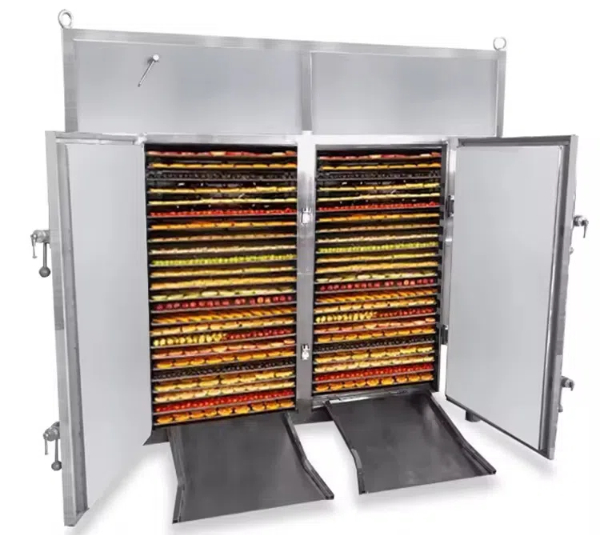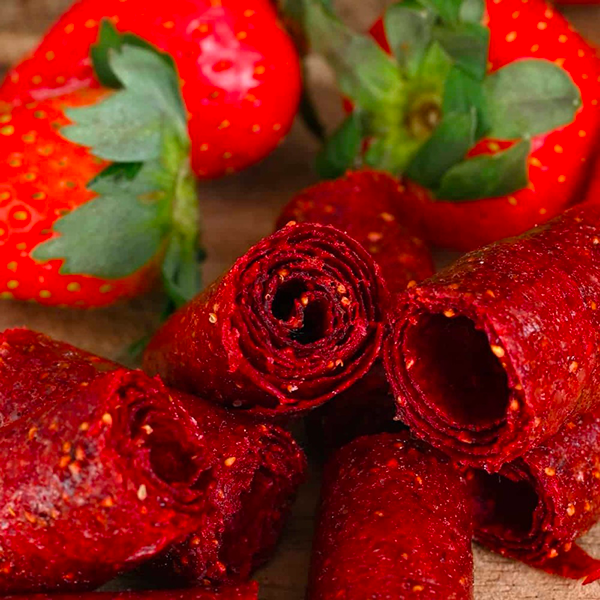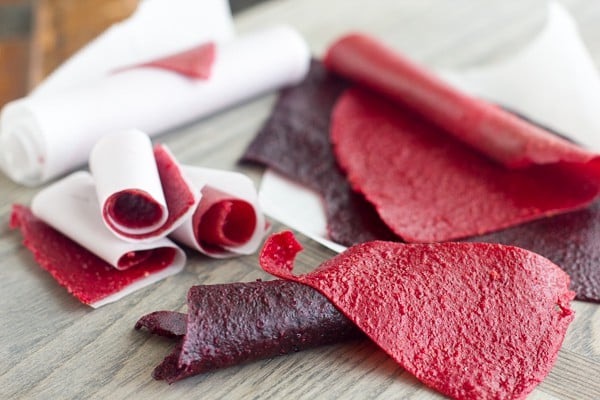
Content Menu
● What Is a Fruit Dehydration Machine?
● Key Factors to Consider When Choosing a Fruit Dehydration Machine
>> 1. Airflow Design
>> 2. Capacity
>> 3. Temperature Range
>> 4. Build Material
>> 5. Noise Level
● Top Features to Look For in a Fruit Dehydration Machine
>> 1. Timer and Auto Shut-Off
>> 2. Transparent Door
>> 3. Expandable Trays
>> 4. Energy Efficiency
>> 5. Dishwasher-Safe Trays
● Best Practices for Using a Fruit Dehydration Machine
>> 1. Prepare Fruits Properly
>> 2. Arrange Fruits Evenly
>> 3. Monitor Drying Times
>> 4. Store Dried Fruits Properly
● Recommended Fruit Dehydration Machines
● Conclusion
● FAQ
>> 1. How long does it take to dehydrate fruits?
>> 2. Can I dehydrate multiple types of fruit at once?
>> 3. Are plastic dehydrators safe?
>> 4. What is the ideal temperature for dehydrating fruit?
>> 5. Do I need to rotate trays during dehydration?
● Citations:
Food dehydration is a growing trend among health-conscious individuals and businesses alike. Whether you're preserving seasonal fruits, creating healthy snacks, or producing dried goods for commercial purposes, selecting the right fruit dehydration machine is essential. With so many models and features available on the market, it can be challenging to decide which one suits your needs. This guide will walk you through the key considerations, features, and best practices to help you choose the best machine for your home or business.

What Is a Fruit Dehydration Machine?
A fruit dehydration machine removes moisture from fruits while retaining their nutrients, flavor, and texture. By circulating heated air around sliced fruits, these machines ensure even drying, which prevents spoilage and extends shelf life. They are widely used in homes and businesses to produce dried fruits, fruit leathers, and even ingredients for gourmet cooking.
Dehydrated fruits are not only delicious but also versatile. They can be used as standalone snacks, added to trail mixes, or incorporated into baked goods like muffins and granola bars. For businesses, fruit dehydration machines offer an excellent opportunity to produce value-added products with extended shelf lives.
Key Factors to Consider When Choosing a Fruit Dehydration Machine
When selecting a fruit dehydration machine, it's important to evaluate your specific needs and preferences. Here are the most critical factors to consider:
1. Airflow Design
The airflow design of a dehydrator determines how evenly it dries food:
- Horizontal Airflow: Fans are located at the back or side of the machine. These models ensure even drying across all trays without requiring rotation. They are ideal for both home and business use.
- Vertical Airflow: Fans are placed at the top or bottom of the unit. While these models are compact and affordable, they may require frequent tray rotation to achieve uniform drying.
2. Capacity
The capacity of a dehydrator depends on how much fruit you plan to dry at once:
- For home use: Compact machines with 4–6 trays are sufficient for small batches.
- For business use: Larger models with expandable trays (up to 20) allow higher production volumes.
If you're running a commercial operation, consider industrial-grade dehydrators that can handle bulk quantities efficiently.
3. Temperature Range
Different fruits require specific temperatures for optimal drying:
- Soft fruits like berries: 130°F–140°F
- Dense fruits like apples: 145°F–160°F
Choose a machine with adjustable temperature settings to accommodate various types of produce.
Some advanced models also come with preset temperature settings for different food types, making them user-friendly for beginners.
4. Build Material
The material of the dehydrator affects its durability and ease of cleaning:
- Plastic Models: Lightweight and affordable but less durable over time.
- Stainless Steel Models: Sturdy and ideal for professional use due to their longevity and aesthetic appeal.
Stainless steel machines are also more resistant to staining and odors compared to plastic ones.
5. Noise Level
Since dehydrators often run for several hours (or even days), noise levels can be an important consideration:
- Quieter models are ideal for home use, especially if you plan to run them overnight.
- For businesses operating in separate facilities, noise may not be as significant an issue.

Top Features to Look For in a Fruit Dehydration Machine
To ensure you get the most out of your investment, look for these essential features:
1. Timer and Auto Shut-Off
A programmable timer ensures precision in drying times, while an auto shut-off feature prevents over-drying or overheating. These features are particularly useful if you're multitasking or running a business that requires consistent results.
2. Transparent Door
A see-through door allows you to monitor progress without interrupting the drying process by opening the machine. This feature is especially helpful when drying delicate fruits that require close attention.
3. Expandable Trays
Some models allow you to add extra trays as needed, making them versatile for both small-scale and large-scale operations. This feature is ideal if you plan to scale up your production in the future.
4. Energy Efficiency
Machines with efficient power usage (e.g., 600–1000 watts) reduce operational costs while maintaining performance. Energy-efficient models are particularly beneficial for businesses that run their machines frequently.
5. Dishwasher-Safe Trays
Cleaning up after dehydration can be tedious, especially when dealing with sticky fruits like mangoes or pineapples. Machines with dishwasher-safe trays make cleanup quick and hassle-free.
Best Practices for Using a Fruit Dehydration Machine
To achieve the best results with your fruit dehydration machine, follow these tips:
1. Prepare Fruits Properly
Proper preparation is key to successful dehydration:
- Wash fruits thoroughly to remove dirt and pesticides.
- Slice fruits uniformly so they dry evenly.
- Pre-treat certain fruits (e.g., apples) with lemon water or ascorbic acid solutions to prevent browning during drying.
2. Arrange Fruits Evenly
Avoid overlapping slices on trays as this can lead to uneven drying. If using a vertical airflow model, rotate trays periodically to ensure consistent results.
3. Monitor Drying Times
Drying times vary depending on the type of fruit and its moisture content:
- Apples: 6–12 hours
- Bananas: 8–12 hours
- Grapes: 20–36 hours
Check progress every few hours and remove dried fruits promptly once they reach the desired texture.
4. Store Dried Fruits Properly
Once dried, store fruits in airtight containers or vacuum-sealed bags to maintain freshness. Keep them in a cool, dark place away from direct sunlight.
Recommended Fruit Dehydration Machines
Here's a comparison of some popular fruit dehydration machines available on the market:
| Model Name | Airflow Type | Tray Capacity | Temperature Range | Price Range |
| Cosori Premium | Horizontal | 6 trays | 95°F–165°F | $160 |
| Tribest Sedona Express | Horizontal | 11 trays | 77°F–167°F | $550 |
| Nesco Gardenmaster | Vertical | Up to 20 trays | 90°F–160°F | $125 |
| Excalibur 9-Tray | Horizontal | 9 trays | 105°F–165°F | $269 |
Each of these models offers unique features tailored to different needs—whether you're looking for affordability, high capacity, or advanced functionality.
Conclusion
Choosing the best fruit dehydration machine depends on your specific needs—whether you're a home user looking for convenience or a business owner requiring high-capacity production. Key factors such as airflow design, capacity, temperature range, build quality, and additional features like timers and dishwasher-safe trays should guide your decision-making process.
By investing in the right machine, you'll enjoy perfectly dried fruits that retain their natural flavors and nutrients while minimizing waste and extending shelf life.

FAQ
1. How long does it take to dehydrate fruits?
Drying times vary depending on the fruit type and thickness:
- Apples: 6–12 hours
- Bananas: 8–12 hours
- Grapes: 20–36 hours
Always refer to your dehydrator's manual for recommended drying times.
2. Can I dehydrate multiple types of fruit at once?
Yes! However:
- Ensure similar drying times.
- Avoid mixing strong-flavored items (e.g., onions) with sweet fruits like strawberries or mangoes to prevent flavor transfer.
3. Are plastic dehydrators safe?
Yes! Most plastic dehydrators use BPA-free materials that are food-safe. However:
- Stainless steel models are preferred for durability.
- Plastic may absorb odors over time if not cleaned properly.
4. What is the ideal temperature for dehydrating fruit?
The optimal range is between 130°F and 160°F depending on the fruit's moisture content:
- Lower temperatures preserve more nutrients.
- Higher temperatures speed up drying but may affect texture if not monitored closely.
5. Do I need to rotate trays during dehydration?
For vertical airflow models: Yes! Rotating trays ensures even drying since airflow may not reach all areas equally.
For horizontal airflow models: No! These machines typically provide uniform drying without rotation.
Citations:
[1] https://www.thespruceeats.com/best-food-dehydrators-4077285
[2] https://www.goodhousekeeping.com/cooking-tools/g30200878/best-food-dehydrator/
[3] https://www.alamy.com/stock-photo/food-dehydrator.html
[4] https://www.youtube.com/watch?v=8HC8hu5aa14
[5] https://learn.eartheasy.com/guides/a-beginners-guide-to-dehydrating-food/
[6] https://www.seriouseats.com/best-food-dehydrators-5216308
[7] https://www.youtube.com/watch?v=mtDzdYoyeR8
[8] https://www.youtube.com/watch?v=9DSGcVhjHEc
[9] https://pleasanthillgrain.com/resources/dehydrators-buying-guide
[10] https://www.youtube.com/watch?v=Zl4wTcCPJu0
[11] https://www.youtube.com/watch?v=1fP2rSLjys4
[12] https://www.youtube.com/watch?v=2RCRSi9AF5E
[13] https://www.foodandwine.com/lifestyle/kitchen/best-food-dehydrators
[14] https://littlegreendot.com/dehydrator-buying-guide/
[15] https://www.treelinereview.com/gearreviews/best-food-dehydrator
[16] https://www.nytimes.com/wirecutter/reviews/best-food-dehydrator/
[17] https://www.foodnetwork.com/how-to/packages/shopping/product-reviews/best-food-dehydrators
[18] https://www.youtube.com/watch?v=cXtcaozMLfw
[19] https://www.istockphoto.com/photos/dehydrator
[20] https://stock.adobe.com/search?k=dehydrator
[21] https://www.allrecipes.com/article/how-to-use-a-food-dehydrator/
[22] https://www.shutterstock.com/search/food-dehydrator











